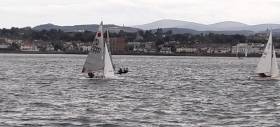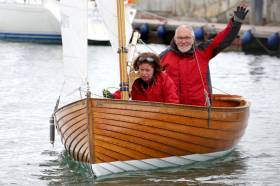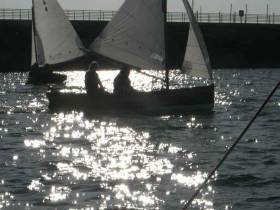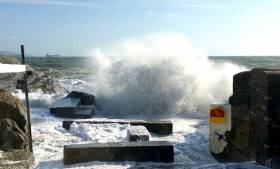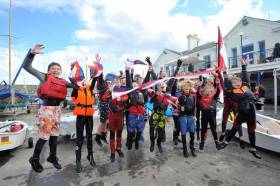Displaying items by tag: Dublin Bay
New Month, New Courses for DBSC Fireballs on Dublin Bay
In a break from the growing trend of setting windward-leeward courses on a Tuesday night for dinghy racing on Dublin Bay, OOD Ben Mulligan (Flying Fifteens) & the DBSC Race Management Team set Olympic courses for the August 1st DBSC Fleet – in partial response to the request from the IDRA Class that these courses be set in advance of their impending Nationals writes Cormac Bradley. It was also a good night for Olympic courses with an offshore breeze of good strength and flat water even if there were large wind shifts.
Six Fireballs were on the start line with a few crew changes in the mix. Stephen Oram (15061) engaged the services of Olympian (470) Phil Lawton to helm while Conor Clancy (14807) had Teddy Byrne on board as crew. Also out were two all-lady combinations – Hermine & Louise (14691) and Cariosa & Marie (14854). Frank Miller (14713) brought in another of his roster of “contracted crews”, Grattan Donnelly whom we haven’t seen for a while and also making a welcome return was David & Michael Keegan (14676).
The forecast was for 10 – 12 knots from a SW direction with a possibility of drizzle which thankfully stayed away. There was some movement of the breeze but it still provided a reasonable beat with the fleets spread across the course.
The first start was reasonably even with the fleet distributed along the line. However, as I was on the committee boat (sound signal) and involved in the subsequent start (Lasers), I wasn’t able to follow the “nitty-gritty” action off the start line. My recall is that the boats that went left initially, even if not for very long came out best at the top end. Even more confusing in a six boat fleet where there are only two spinnakers that aren’t red, I got the opening sequence of spinnakers wrong at the first weather mark – assuming it was the Olympian helm leading the way round – only to find out afterwards that it was Miller & Donnelly. Clancy/Byrne rounded second, which meant that Lawton/Oram were third followed by Power, McKenna and Keegan. Immediately after the spinnaker hoist Clancy/Byrne (blue spinnaker) went over the top of Miller/ Donnelly (red) and to my mind this was the significant place change of the entire race, because Clancy & Byrne led the rest of the race to finish first.
While Lawton & Oram may have closed on occasion, it became apparent that they had to give as much attention to watching Miller & Donnelly as they were to catching Clancy & Byrne. Clancy & Byrne had the comfort of being able to watch the chasing pack with the comfort of a bit of distance between them.
A tighter race was taking place between the two all-lady teams with McKenna & O’Keeffe chasing the other pair for all of the race and ultimately being unsuccessful! On the downwind leg of the sausage the leading three boats, Clancy, Lawton & Miller went right before Clancy broke left and then gybed back again to cover the other two in the run-in to the leeward mark for the second time. Up the third beat Clancy & Byrne worked the middle and left of the course while Lawton/Oram and Miller/Donnelly worked the right hand side. It didn’t help!
The 4-lap race was shortened to three laps and a second race was set with the marks staying in their original positions. A short single lap race was signalled for the second race due to a combination of time, light and a breeze that was starting to show signs of fading.
For the second start, a wind switch and the scheduled change of the tide saw the fleet playing “chicken” at the pin end of the line, each boat in turn approaching the pin and performing a pirouette to duck out. The last boat to have the door slammed shut on them was McKenna & O’Keeffe, by Clancy & Byrne, who executed a perfectly timed start on port at the pin. McKenna went to the back of the queue and Lawton/Oram followed Clancy & Oram across the line. The latter pair then took a hitch to the left to clear their air. The Keegans were furthest to leeward of the bunch and found themselves out on the right of the beat. The wind was starting to die at this stage of the evening and given the grey skies and the time, the single lap decision appeared to be vindicated.
Clancy & Byrne rounded the weather mark first and led to the finish, followed by Lawton & Oram, Miller & Donnelly, Power & Barry, McKenna & O’Keeffe and Keegan & Keegan.
Again the “race within a race” was between the two all-lady teams with Power & Barry winning by a short distance.
|
DBSC: Tuesday Nights: Series 3 (4 races, 1 discard) |
Pts |
|||
|
1 |
Conor & James Clancy/Teddy Byrne |
14807 |
RStGYC |
3 |
|
2 |
Frank Miller & Ed Butler/Grattan Donnelly |
14713 |
DMYC |
6 |
|
3 |
Noel Butler/Phil Lawton & Stephen Oram |
15061 |
NYC |
11 |
|
Louise McKenna & Hermine O’Keeffe |
14691 |
RStGYC |
11 |
|
|
4 |
Cariosa Power & Marie Barry |
14854 |
NYC |
15 |
With next Tuesday following a Bank Holiday in Ireland (Monday 7th), there will be no racing which means there is only one Tuesday night session before the Fireball Europeans in Lyme Regis, Devon, UK starting Saturday 18th August and running through to the following Friday. Facebook posts from Fireball UK, hosting in tandem with Lyme Regis Sailing Club, this morning (02/08) state that the entry currently stands at 81 boats with entries from nine countries. Ireland will have three representatives at the regatta.
In other news, Lough Derg Yacht Club has confirmed the hosting of the Irish Fireball Nationals over the weekend of 15- 17 September. All Irish Fireballers are encouraged to attend this event in this very hospitable club. Regatta documentation will be prepared shortly.
Chloe Wins Buckingham Cup As Dun Laoghaire Water Wags Are 'Discommoded By Cruise Liner'
For the second handicap race of the year, for The Buckingham Cup and The Wigham Trophy, the Dun Laoghaire Water Wags were discommoded by a 9,975 ton, 440ft long cruise liner, The Star Pride with her 208 passengers and 164 crew.
She was scheduled to leave the Carlisle Pier at 18.00hrs but there was an upset to her plans. Allegedly, a replacement part was required for her engines, which was being delivered from Dublin Port by car, leaving the latter venue at 18.00hrs. Instructions were conveyed to the Water Wags by Harbour Company officials. The reality was something different. At approx. 18.45hrs the tugboat Burfort arrived in Dun Laoghaire harbour joined by the Dublin Port harbour pilot. They set to work quickly, towed The Star Pride by the stern, until the liner was in the centre of the harbour. They then spun her, until the bow was pointing towards the harbour mouth.
The Wags quickly launched, the committee boat then laid a four-lap course with a start line near the marina entrance, and windward mark under the East Pier Lighthouse. The first Water wag to start was Nandor, followed half a minute later by Chloe, and Coquette, Polly and Scallywag two minutes later. Last to start after the passage of six minutes were Moosmie, Gavotte, Swift, Tortoise and Eva.
As the race developed the early starters merged with some of those faster boats attacking from behind. It soon became clear that the leaders, mother and daughter team of Kate & Amy O’Leary in Chloe and Mc Bride & McBean in Nandor were in for a great battle. A similar battle developed between Hal Sisk and Sue Westrup in Good Hope and Ian Magowan in the recently restored Mary Kate. At the finish, the order was:
1st – 34, Chloe. Kate & Amy O’Leary
2nd. -26, Nandor, Brian McBride and Stuart McBean
3rd.- 6, Mary Kate, Ian & Jenny Magowan
4th. -18, Good Hope
5th. -46, Mademoiselle
6th. - 3, Pansy
7th. -Moosmie
8th. - 38, Swift
9th. - 10, Sprite
10th. -30 Sara
11th. -45, Mariposa
12th. -42, Tortoise
13th. -17, Coquette
With its focus on quality over quantity, next week's Volvo Dun Laoghaire Regatta has grown over 12 years into one of Ireland’s premiere sporting events, let alone sailing – and is now competing with the best in Europe.
If you want a snapshot of the sport of sailing in Ireland, Scotland and Wales in 2017, where would you go? Dun Laoghaire is the answer.
The pages of this year's 2017 Volvo Dun Laoghaire Regatta programme detail over 450 boats in 35 classes, and in so doing they provide the most accurate picture of the Irish Sea sailing scene.
Over four days in July, 300 volunteers will stage 290 races for a mix of cruiser–racers, one-design keelboats and dinghies, plus a unique classics division, all wrapped up in one Irish Sea sail-fest – with Dun Laoghaire as its centre.
In assembling such an armada, Dun Laoghaire Regatta (VDLR) has become, at its seventh staging, not only the country’s biggest sailing event — with over 2,500 sailors competing — but also one of Ireland’s largest participant sporting happenings.
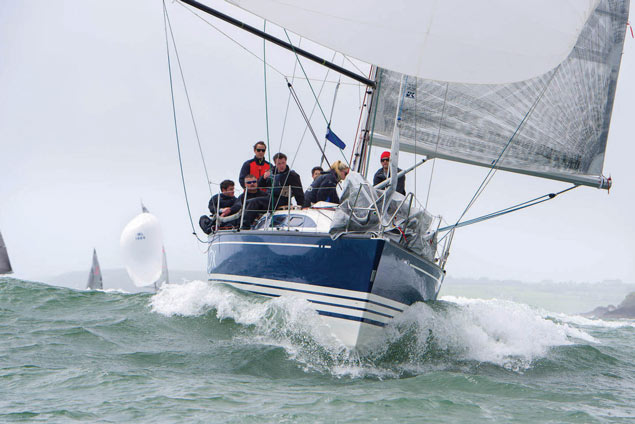 Recently crowned ICRA class two champion, Equinox, skippered by Ross McDonald, is one of 27 entries from Howth Yacht Club. Photo: Bob Bateman
Recently crowned ICRA class two champion, Equinox, skippered by Ross McDonald, is one of 27 entries from Howth Yacht Club. Photo: Bob Bateman
But what’s even more satisfying for the Dun Laoghaire organisers is that nearly half the entries are visiting boats – an indication of the future international prospects of the regatta.
It’s a big achievement for the capital’s waters, given so many other regattas are struggling for numbers.
Focus on quality
‘Never mind the quality, feel the width’ has been a criticism of modern-day regattas where organisers mistakenly focus on being the biggest in an effort to be the best.
And at a time when regatta fleets have collapsed, there is some irony in the fact that Dun Laoghaire, with its own local fleet of 300 boats, never set out to be the biggest yet nevertheless has emerged as the yacht racing hub for the Irish Sea, from the Clyde to Lands End.
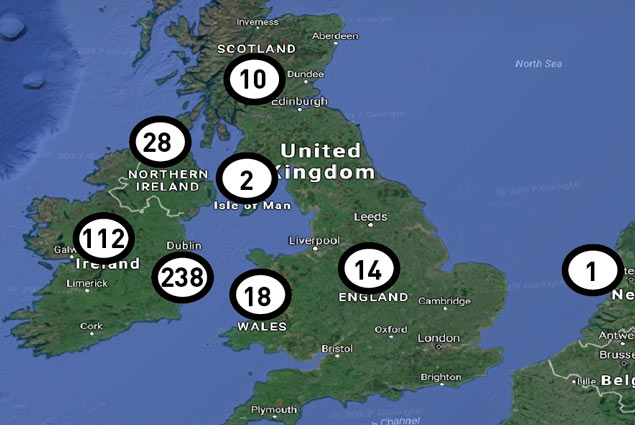 The bulk of entries are Dublin based but the regatta has a growing reach across the Irish Sea
The bulk of entries are Dublin based but the regatta has a growing reach across the Irish Sea
Dublin Bay’s priority focussed instead on quality racing, even after it got off to a spectacularly bad start in 2005 when the event was becalmed for four days.
The idea to rekindle a combined Dublin Bay event had resurfaced after an absence of almost 40 years, mostly because of the persistence of a band of passionate Dun Laoghaire sailors who believed that their home could become the ‘Cowes of the Irish Sea’ if the town and the local clubs worked together.
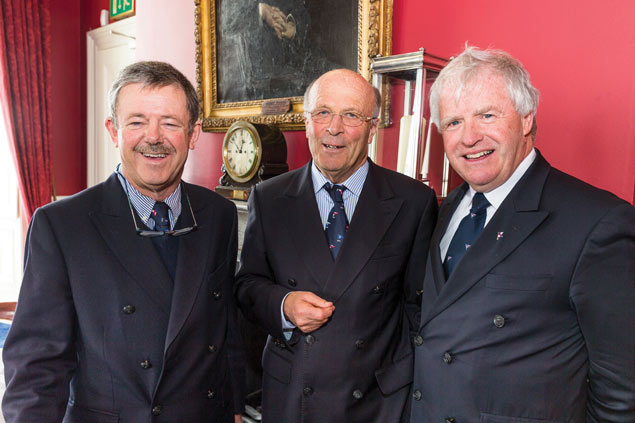 VDLR Beginnings – In 2004, the then Rear Commodores of RStGYC, Owen McNally, (left) RIYC, Timothy Goodbody (centre) and NYC's Ronan Beirne were tasked by the Combined Clubs Committee, chaired by Phil Smith , to submit a proposed format for a combined regatta involving all four waterfront clubs. This they did over a very enjoyable dinner and submitted their proposals which were subsequently adopted by the all four waterfront clubs (Dun Laoghaire Motor Yacht Club, National Yacht Club, Royal Irish Yacht Club and Royal St George Yacht Club, and the inaugural event was chaired by Brian Craig in 2005. Thirteen years on from that, the same, now ex- Rear Commodores, met again to reflect on the development of this great regatta over a very social and enjoyable lunch. Today, the biennial Dun Laoghaire Regatta is a firm fixture on the sailing calendar and run under Dublin Bay Regattas Limited, under the Chairmanship of Dermot Reidy (DMYC).
VDLR Beginnings – In 2004, the then Rear Commodores of RStGYC, Owen McNally, (left) RIYC, Timothy Goodbody (centre) and NYC's Ronan Beirne were tasked by the Combined Clubs Committee, chaired by Phil Smith , to submit a proposed format for a combined regatta involving all four waterfront clubs. This they did over a very enjoyable dinner and submitted their proposals which were subsequently adopted by the all four waterfront clubs (Dun Laoghaire Motor Yacht Club, National Yacht Club, Royal Irish Yacht Club and Royal St George Yacht Club, and the inaugural event was chaired by Brian Craig in 2005. Thirteen years on from that, the same, now ex- Rear Commodores, met again to reflect on the development of this great regatta over a very social and enjoyable lunch. Today, the biennial Dun Laoghaire Regatta is a firm fixture on the sailing calendar and run under Dublin Bay Regattas Limited, under the Chairmanship of Dermot Reidy (DMYC).
Although fickle winds conspired against them in 2005, the support since then from all four Dun Laoghaire waterfront yacht clubs – the Dun Laoghaire Motor YC, National YC, Royal Irish YC and Royal St George YC – in association with the two racing clubs of Dublin Bay SC and Royal Alfred YC, gave them the momentum to carry on.
Numbers peaked in 2007 with over 480 entries, and while that figure remains a record, it is this year’s turnout – matching 2005 – that shows the event is now a confirmed highlight on the British and Irish yachting calendar.
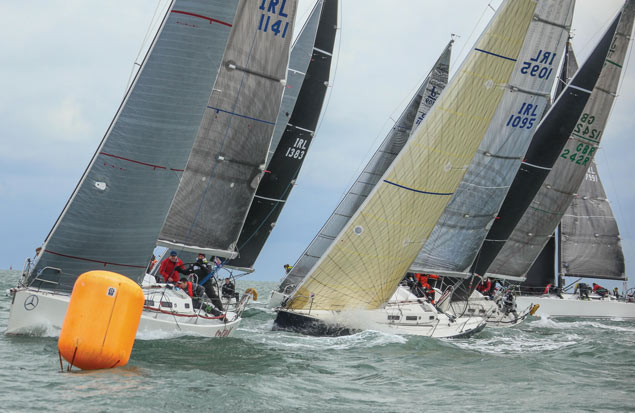 Of the six cruiser classes there is a strong argument that not only is the 27–boat VDLR Cruisers One division the class of the event but it’s also the class of the year. 11 J109s (pictured above) will race as part of the red hot fleet. Photo: Afloat.ie
Of the six cruiser classes there is a strong argument that not only is the 27–boat VDLR Cruisers One division the class of the event but it’s also the class of the year. 11 J109s (pictured above) will race as part of the red hot fleet. Photo: Afloat.ie
Stronger than expected
If success is measured by fleet size, then the VDLR has looked on course for a buoyant seventh edition since April, when half of its massive fleet had already signed up.
More than 2,500 sailors and 800 visitors will race across 35 classes, so outgoing Irish Sailing Association (ISA) President David Lovegrove rightly noted at the regatta launch that it will be one of Ireland’s biggest sporting events when the first gun fires on July 6.
Only once since its inaugural outing in 2005 have numbers dipped below 400, and that was in the teeth of recession in 2013. But even then the fleet only dropped to 393, just 93 lower than 2007’s record year. In 2017 the numbers are tantalisingly close to matching that peak.
 The Dublin Bay Mermaid (above) will have a strong 15–boat turnout. A strong Skerries Sailing Club contingent has swelled the classic clinker fleet that includes national champion Sam Shiels at the helm of number 189 Azeezy
The Dublin Bay Mermaid (above) will have a strong 15–boat turnout. A strong Skerries Sailing Club contingent has swelled the classic clinker fleet that includes national champion Sam Shiels at the helm of number 189 Azeezy
Entries this year are also stronger than expected, as all four Dun Laoghaire clubs bang the drum for the harbour’s bicentenary year.
Well over half of all entries – 60% in fact – come from the locality, with the Royal Irish and National YCs providing half of that number between them.
In keeping with the local celebratory mood, this year a special Kingstown 200 Cup, kindly presented by Dun Laoghaire Harbour Company, will be awarded to the ‘Most Outstanding Classic Boat of Regatta’.
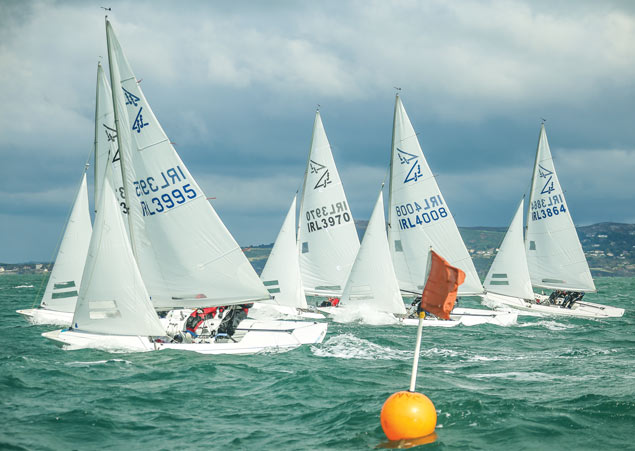 Dublin Bay’s Flying Fifteen fleet has been a mainstay of the regatta since 2005. A 17–boat fleet is entered this year
Dublin Bay’s Flying Fifteen fleet has been a mainstay of the regatta since 2005. A 17–boat fleet is entered this year
Unique facilities
Tim Goodbody, chairman of the VDLR in 2015 and 2017 (and a Cruisers One contender in his own right), believes the regatta owed its prominence in European sailing events to a number of factors.
“One of the reasons it attracts so many entrants is that it is one of the least expensive sailing events in Europe, thanks to generous sponsorship and support,” he said.
Another reason is certainly Dun Laoghaire’s unique facilities. This is the place where the modern rules of sailing were framed over 150 years ago. The Victorians built the best of yachting venues on Dublin’s south shore so that the sailors of today, four generations later, get to enjoy the fruit of their labours.
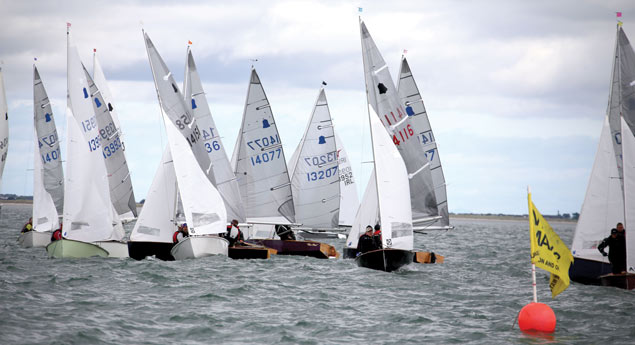 Not only is the 26-boat GP14 fleet one of the largest of the ten competing dinghy classes it also has participation across the country from Moville in Donegal to Youghal in Couty Cork. The boats to watch, of course, in this Leinster Championship fleet will undoubtably be the match between Greystones Sailing Club’s Shane MacCarthy in 14203, the current World Champion and Olympian Ger Owens in 14076. Owens, sailing with Mel Morris, ended MacCarthy’s unbeaten run (on the World Champions) home waters at the Purcell Trophy in May.
Not only is the 26-boat GP14 fleet one of the largest of the ten competing dinghy classes it also has participation across the country from Moville in Donegal to Youghal in Couty Cork. The boats to watch, of course, in this Leinster Championship fleet will undoubtably be the match between Greystones Sailing Club’s Shane MacCarthy in 14203, the current World Champion and Olympian Ger Owens in 14076. Owens, sailing with Mel Morris, ended MacCarthy’s unbeaten run (on the World Champions) home waters at the Purcell Trophy in May.
Dun Laoghaire is a beautiful working and residential seaside town about 12 km (7.5 miles) south of Dublin city centre and 20 km (12 miles) from the Irish capital’s international airport.
Even from mainland Britain, it’s closer than many might think. Sailors from the Ribble, Mersey, Menai Strait, Anglesey, Cardigan Bay and Isle of Man have to travel three times the distance to the Solent as they do to Dublin Bay.
This is one of the major selling points of the Irish event, and explains the range of entries from 69 different clubs around Ireland, including 28 boats from Northern Ireland.
Across the Irish Sea, two boats are coming from the Isle of Man, 18 from Wales, 10 from Scotland and 14 from England. In a nod to organisers that a European market might be worth looking at for 2019, there is a single entry from Holland.
 Dun Laoghaire Harbour's compact site has world class sailing clubs and race areas adjacent to a modern town with a Five Gold Anchor marina of 820 berths at its heart Photo: Michael Chester
Dun Laoghaire Harbour's compact site has world class sailing clubs and race areas adjacent to a modern town with a Five Gold Anchor marina of 820 berths at its heart Photo: Michael Chester
Dun Laoghaire is also unique in sailing terms because there is only a short sail to the race areas from a Five Gold Anchor marina of 820 berths. Rapid transport links, local hotels, bars and restaurants, and four unique clubs positions it as a strong rival to any other European venue
And let’s not forget the social side. The regatta has built up an enviable reputation ashore for exciting live music and entertainment, and this year’s full social programme promises to be no different.
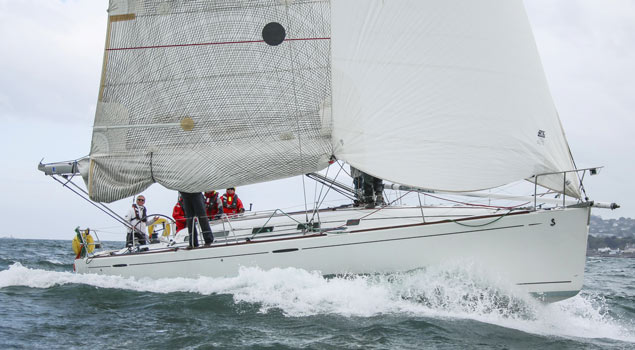 Now firmly established as part of the VDLR mix after its 2015 introduction, the 26-boat offshore class includes many regular ISORA competitors including Derek Martin’s Beneteau 44.7 Lively Lady (pictured) from the Royal Irish Yacht Club
Now firmly established as part of the VDLR mix after its 2015 introduction, the 26-boat offshore class includes many regular ISORA competitors including Derek Martin’s Beneteau 44.7 Lively Lady (pictured) from the Royal Irish Yacht Club
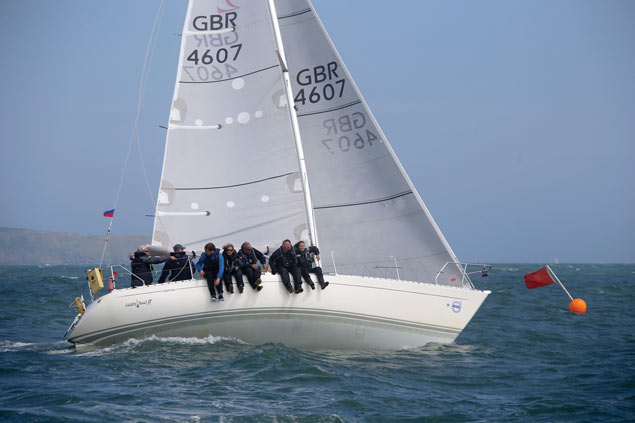 The Sigma 33 is one of the biggest one design cruiser fleets with 20 entries. The long established Dublin Bay class merged with class two for local DBSC racing this year but will hold a special One Design Dun Laoghaire bicentennial Race Day on Friday, 7th July. Pictured is Alan Harper’s Scottish entry Leaky Roof 2 from the Clyde
The Sigma 33 is one of the biggest one design cruiser fleets with 20 entries. The long established Dublin Bay class merged with class two for local DBSC racing this year but will hold a special One Design Dun Laoghaire bicentennial Race Day on Friday, 7th July. Pictured is Alan Harper’s Scottish entry Leaky Roof 2 from the Clyde
Top quality racing
But the action on the water is what it’s all about. From the Baily Lighthouse at the northern entrance to Dublin Bay across to Dalkey Island in the south, there will be seven separate courses laid out for top quality racing.
Indeed, 10 classes have included the regatta as part of their championship calendar in 2017: GP14s, 420s and Mermaid dinghies are racing for Leinster honours, while SB20s, J24s and Squibs will decide East Coast titles, and the Sigma 33s, Beneteau 21s and the Wayfarers will race for national trophies. The vintage Water Wag class will race for a new trophy, The Collen Cup.
 The 15–boat Beneteau 211s are holding the Irish championships as part of VDLR 2017
The 15–boat Beneteau 211s are holding the Irish championships as part of VDLR 2017
Championships running as part of VDLR 2017
Royal Dee Yacht Club Irish Sea Offshore Championship
Irish Sigma 33 National Championship
Irish Wayfarer National Championship
Beneteau 211 Irish Championship
GP14 Leinster Championship
420 Leinster Championship
Mermaid Leinster Championships
SB20 Southern Championships
J24 East Coast Championship
Squib East Coast Championship
Read the entry list class by class starting here
Just a day late for Dun Laoghaire harbour's 200th commemorations and 24 hours early for Dublin Port's Riverfest there is no doubting the evocative age of sail with the arrival of two tall ships sailing into Dublin Bay this morning.
The Earl Of Pembroke is moored in Scotsman's Bay, on the southside of Dublin Bay. The authentic square rigger is a replica of HMS Endeavour, the ship in whcih Captain Cook travelled to Australia in 1768. The modern Earl of Pembroke is 'for hire' for filming, charity and corporate events, as well as for personal charters and holidays. Read more on the Earl Of Pembroke here. The Earl of Pembroke is expected to sail from Dun Laoghaire up the River Liffey tomorrow at noon.
Read our Tall Ships Riverfest preview here
 Kaskelot, one of the last classic wooden Tall Ships, arrives in Dun Laoghaire Harbour
Kaskelot, one of the last classic wooden Tall Ships, arrives in Dun Laoghaire Harbour
The Kaskelot, a three-masted barque, is one of the largest remaining wooden ships in commission. She is moored in Dun Laoghaire Harbour today in advance of the weekend's Dublin Port's Riverfest that is previewed here. Read more on the Kaskelot here.
Although Riverfest is advertising eight tall ship arivals, there are only four visiting Dublin which could in any way be called a Tall Ship. After the arrival of the two this morning, it’s all eyes on the horizon for the Shtandard, the great Russian Tall Ship that will also visit Drogheda Port's Maritime Festival later this month.
Within Dublin Bay there currently are twenty-one classes of racing yachts. It might come as a surprise to many, that currently the largest class is Dublin Bay is the Water Wag class with 33 boats entered for the 2017 season. With a big class, the first question that should be asked is: How many boats compete regularly in class racing? In the case of the Water Wags, 21 boats launched and reached the start line, which was set up for a wind coming at 135 degrees (south east) at about 7 knots.
The start line was set with a small bias towards the pin end, but despite an even spread of Water Wags over the full length of the line, the group closest to the flagship were OCS when there was 20 seconds to go to the start. A general recall was indicated.
On the second attempt to start the line bias was retained, and again some boats jumped the gun, so everybody was called back.
On the third attempt the fleet behaved properly, a ‘all clear’ was declared. It was a long beat with two choices, head towards the harbour mouth where one would have to nose the young flood time, or head towards the marina breakwater where the tide would be in your favour. Eva, Swift and Barbara headed to the harbour mouth, and found that they had more wind strength than those who headed inshore. At the windward mark the order was Eva, Swift, Barbara, Mademoiselle, Pansy. After one lap the order changed to Swift, Eva, Mollie. The race was two laps long and at the finish the order was:
1st – 38, Swift, Guy & Jackie Kilroy.
2nd - 41, Mollie, Claudine Murphy.
3rd.-33, Eva, Katie Tingle.
4th. Skee, Jonathan & Carol O’Rourke.
5th - 8, Barbara, Ian and Judith Malcolm
6th. – 15, Moosmie, David MacFarland.
7th- 3, Pansy, Vincent Delany & Emma Webb.
8th. – 42, Tortoise, William Prentice and Moselle Hogan.
9th. – 4, Vela, Philip Mayne & Brian Bond.
10th. - 46, Mademoiselle.
11th. - 44, Scallywag.
12th. -16, Penelope.
13th. - 45, Mariposa.
14th. - 31, Polly.
15th. –43, Freddie,
16th. - 6, Mary Kate.
17th. -18 Good Hope.
18th. - 20, Badger.
19th. -40, Swallow.
20th. - 34, Chloe.
21st. – 26, Nandor.
Overall series of three races is won by Swift.
DBSC Saturday racing got its second cancellation today as winds gusted to 30–knots on Dublin Bay. The 2017 Saturday season has yet to sail with both races of the series cancelled so far.
Even though winds are forecast to moderate this afternoon there was a unanimous decision on safety grounds made by all three DBSC race officers because of the big seas running on the Bay.
Thursday racing, however, has proved more fruitful with ideal conditions last Thursday for some excellent heavy air racing. The Water Wags also raced on Wednesday as did the dinghies and keelboats on Tuesday.
Meanwhile, DBSC organisers have amended its Course Card 3: Time Limits for the Green Fleet. The target time limit for each race will be 60 minutes after the start of the race. Boats failing to finish within 10 minutes after the first boat sails the course and finishes will be scored DNF.
22–Boat Water Wag Turnout Includes A Capsize in Wednesday's Lively Race at Dun Laoghaire
It wasn't only last night's Dublin Bay keelboats that were having a lively start to 2017 after the spell of north–easterlies. The DBSC Water Wags also had a pretty lively sail on Wednesday with 22 Wags out in force.
Tim Pearson’s Little Tern capsized and was the only non finisher, it was the second race of a mini series within the overall racing series.
After two races Moosmie - David McFarlane and Ciara Bourke are leading the pack with 2 wins for the Newsom Memorial Cup, Eva with Katie Tingle and Dermot O’Flynn leading Divsion 1B for the Hilposteiner Tankard. Chloe with Kate O’Leary and Hugh Delap are leading Division 2 for the Phyllis Cup.
DBSC Yacht Racing Results for Thursday, May 4 2017
Big seas and a big north easterly breeze made for a lively second DBSC Thursday night race for 22 keelboat classes this evening on Dublin Bay.
IRC One was won by Tony Fox's Gringo from the National Yacht Club. The J109 Something Else (John Hall) from the same club was second with Tim Goodbody's J109 White Mischief third.
In IRC two, Jim McCann's Peridot was the winner with Sigma 33s Rupert (Richard Lovegrove) and Leeuwin (Henry Leonard) second and third respectively.
Results for each class are downloadable below as PDF files.
First DBSC Races Abandoned in Strong Winds
Last night's opening race in the DBSC summer season was abandoned due to strong northerly winds on Dublin Bay. Unfortunately, it was a predictable outcome given earlier forecasts had suggested the prospect of wind in excess of 25 knots by 19:00
National Yacht Club Junior Sailors Celebrate Links to Olympic Silver Medal & America’s Cup
A very special Golden Jubilee coming up in May provides links to an Irish Olympic Sailing Silver Medal, the Fireball World Championship, and the America’s Cup. W M Nixon finds the widest connections go even further than that to include a pioneering world voyage.
It was in May 1967 that the irrepressible Carmel Winkelmann oversaw the first results of a junior sailing initiative at the National Yacht Cub, her home club in Dun Laoghaire. It became a movement which went on which to have nationwide and worldwide ramifications, so much so that within Ireland we’re looking at an unbroken line in Irish sailing which is continued through the club which currently holds the title of ISA Training Centre of the Year, which for 2017 is Foynes Yacht Club on the Shannon Estuary.
That a successful club at the heart of the Atlantic seaboard can trace an almost magic thread back to something which happened at a club on Dublin Bay a long time ago is quite a story in itself. Particularly when the Atlantic seaboard club itself is imbued, as Foynes is, with the spirit of legendary circumnavigator Conor O’Brien. However, when the story is shaping up to continue with the Golden Jubilee as the latest chapter, it gives us an opportunity both to celebrate, and take stock of what it has all meant.
 Foynes Yacht Club, heirs to an Irish tradition of junior sail training which was first formalized by the National Yacht Club 50 years ago. At the Irish Sailing Awards ceremony when Foynes were announced as winners of the ISA Training Centre of the Year Award were (left to right) Simon McGibney (Foynes Senior Instructor), Sailor of the year and Olympic Silver Medallist Annalise Murphy of the National Yacht Club, Elaine O’Mahoney (Foynes Sailing Academy Manager), Pat Finucane (Sailing Academy Principal) and Conor Dillon (Instructor). In a club which is imbued with the spirit of world-girdling Foynes sailor Conor O’Brien, it’s particularly appropriate that Conor Dillon’s sailing CV includes winning the Two-Handed division in the Round Ireland Race, sailing with his father Derek Dillon on a 34-footer. Photo: Inpho
Foynes Yacht Club, heirs to an Irish tradition of junior sail training which was first formalized by the National Yacht Club 50 years ago. At the Irish Sailing Awards ceremony when Foynes were announced as winners of the ISA Training Centre of the Year Award were (left to right) Simon McGibney (Foynes Senior Instructor), Sailor of the year and Olympic Silver Medallist Annalise Murphy of the National Yacht Club, Elaine O’Mahoney (Foynes Sailing Academy Manager), Pat Finucane (Sailing Academy Principal) and Conor Dillon (Instructor). In a club which is imbued with the spirit of world-girdling Foynes sailor Conor O’Brien, it’s particularly appropriate that Conor Dillon’s sailing CV includes winning the Two-Handed division in the Round Ireland Race, sailing with his father Derek Dillon on a 34-footer. Photo: Inpho
But business first. Anyone who has ever taken part in the Junior Training Programme at the National Yacht Club is hereby alerted – if you don’t know already – that on the evening and night of Saturday May 20th, there will be a very special celebration at the clubhouse. The organisers Carmel Winkelmann and Ann Kirwan are particularly keen to trace those who have moved away, but would find much nostalgic pleasure with the meeting of old friends by returning on this day of days. So if that applies to you, or you know anyone to whom it does, please make contact with the key club administrator whom everyone refers to as “Oonagh at the National”, the proper line of contact being [email protected], tel 01-280 5725.
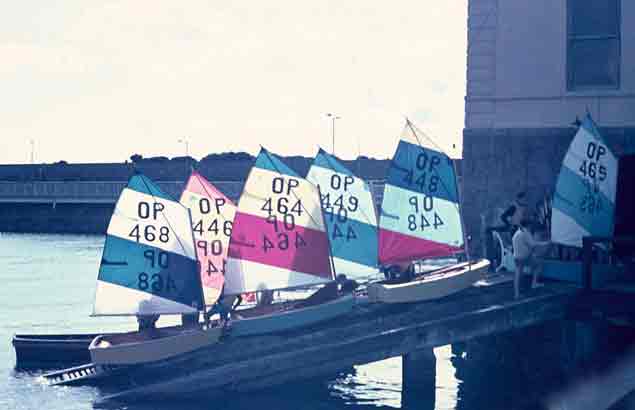 Bright morning of Optimism. The National Yacht Club slipway in 1967, long before the days of an extensive front-of-club platform, with the new dinghies of the Optimist Class being launched out of the cramped boathouse under the club, and down a steep and often very crowded slipway
Bright morning of Optimism. The National Yacht Club slipway in 1967, long before the days of an extensive front-of-club platform, with the new dinghies of the Optimist Class being launched out of the cramped boathouse under the club, and down a steep and often very crowded slipway
To grasp the significance of what is being celebrated, please try to visualize the National Yacht Club as it was fifty years ago. The building itself, standing directly in the harbour, has the air of a fishing lodge in the West of Ireland on its seaward side, and a hint of neo-classicism when seen from the town. But in the early 1960s it was very limited in its shoreside facilites for sailing dinghies. There was a boathouse entered through fine granite arches under the clubhouse itself, but to use it, masts needed to be lowered. It was served by a very steep and easily-crowded slip, while there was access to another slip on the east side of the cub which served a small area where dinghies could be stored. But while there was space for the established classes of Fireflies and some IDRA 14s, some room was also needed for the small tenders for larger yachts moored in the harbour, while the racing keelboats were served by club launches which might be substantial dinghies driven by vintage Seagull outboards.
The concept of a proper dinghy park was still only in its infancy, relatively speaking, for craft such as Dun Laoghaire’s Firefly and IDRA fleets which had been active since the late 1940s. Thus if anyone had a centreboard boat which could reasonably be expected to lie to moorings, she was obliged to do so, and the fleet of small craft lying off the club included the 17ft Mermaids and the 14ft Water Wags.
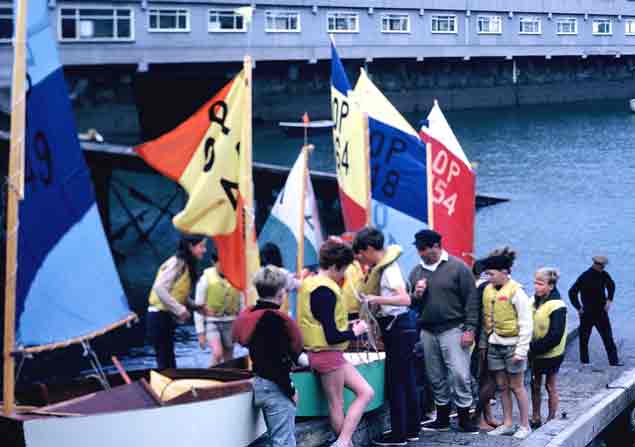 It could get very crowded on that steep slipway. Paddy Kirwan at the centre of a group making do with limited facilities
It could get very crowded on that steep slipway. Paddy Kirwan at the centre of a group making do with limited facilities
To compound the space problems afloat and ashore, during the 1960s the area in the southeast part of Dun Laoghaire Harbour off the National Yacht Club was the focal point for the cross-channel ferry berths. The railway-system serving Mailboat with its emphasis on foot passengers continued to use the Carlisle Pier to the west of the club, but the East Pier was known for a period as the Car Ferry Pier as a busy new roll-on roll-off terminal, which admittedly always had a temporary look about it, had been constructed there to accommodate the new trend in cross-channel travel.
Thus not only was anyone sailing a dinghy from shore at the National YC dong so out of decidedly limited facilities, but they immediately sailed into an area cluttered with a collection of moored boats of all shapes and sizes, and that in turn was set in an area which might have ferry ships berthed close by, or manoeuvring on either side.
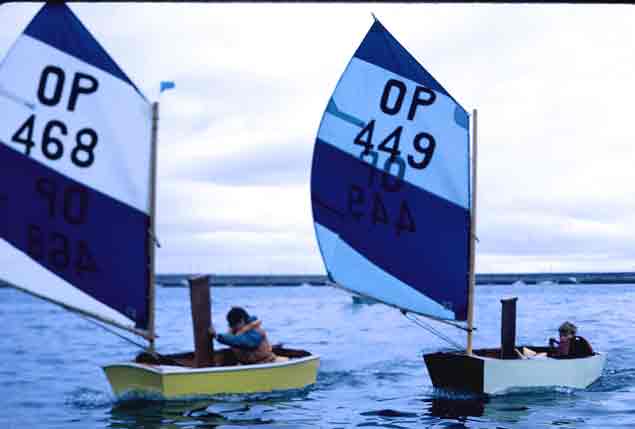 Learning curve. Gina Duffy and John Lavery on a close run in 1967. The latter has won many major championships, including the Fireball Worlds in 1995
Learning curve. Gina Duffy and John Lavery on a close run in 1967. The latter has won many major championships, including the Fireball Worlds in 1995
The comparisons with today’s National Yacht Club with its spacious platform facing out over a much clearer harbour area, and beside it an installation of convenient berthing pontoons, could not be greater. But back in the 1960s, an equally important change was happening – there was a complete re-appraisal of what the most junior sailors really needed in boats and instruction to get the best from the sport.
For sure there were the Fireflies, but in terms of lower age limit they were really aimed at adolescents on the cusp of rapidly growing youth. The other available classes were even more adult-oriented. In fact, the underlying problem was that children going sailing were treated as miniature adults who would somehow pick up the skills of the game through a sort of osmosis, whereas for a crucial period of their lives they would have most benefitted from being treated as a different species, with different boats to meet their needs.
Yet even here, adult views dominated. The grown-ups thought that young people’s boats should at least look like small yachts. Thus a dinghy which was promoted for children by several clubs was the 11ft Yachting World Cartop Heron, which had originally been conceived as a DIY-build which could fit on the roof-rack of the average family car, and was designed with a gunter rig such that all its spars could be stowed within the boat.
It had some good ideas, and with a pretty sheer it fulfilled the adult expectation of what a miniature yacht should look like. But it was surprisingly heavy for its avowed rooftop requirement – you’d have needed a weight-trained family to get it on the car roof. And anyway, it was too large for really small kids who genuinely had the sailing bug.
 The southeast corner of Dun Laoghaire Harbour was very different in 1967, with the East Pier re-designated as the Car Ferry Pier. Yet despite the limitations, the Optimist class quickly caught on after its introduction in 1967
The southeast corner of Dun Laoghaire Harbour was very different in 1967, with the East Pier re-designated as the Car Ferry Pier. Yet despite the limitations, the Optimist class quickly caught on after its introduction in 1967
So a revolutionary approach was needed, and it came thanks to one of the National YC’s international sailing stars, Johnny Hooper. He had achieved Ireland’s first Olympic Race win with Peter Gray in the Flying Dutchman in the 1960 Rome Olympics when the sailing was at Naples. But as an FD campaign towards the 1984 Olympics was prohibitively expensive with the venue in Japan, he returned to his first love of International 505 Racing, and it was at a big 505 championship in Scandinavia in 1965 or thereabouts that he first became aware of the game-changing possibilities of the Optimist for junior sailing.
Scandinavia being rightly renowned for the elegance of its yacht, it speaks volume for the versatility of the Florida-originating Optimist, the “simple little boxboat that sails surprisingly well”, that Scandinavia should lead the movement towards a world body for a boat which, whatever the traditionalists might think, the kids were clearly loving. Founded 1965, the International Optimist Dinghy Association (IODA) had Viggo Jacobsen of Denmark as its first President with his wife Edith as Secretary, and in that same year Johnny Hooper set about introducing the idea of the Optimist to Ireland.
Now if some ordinary Joe had happened to by impressed by an Optimist at some foreign location, and had even brought one home to persuade his fellow sailors that they were looking at the future, the idea probably would have fallen very flat indeed.
But that’s not the Hooper way. Instead, from his highly respected position he quietly targeted fellow National Yacht Club members who were themselves active sailors, but also had children who would benefit from the Optimist experience, and in time a group emerged which was to include initially Johnny Hooper with his wife Bernie giving the longterm involvement, Peter Gray, Paddy & Barbara Kirwan , Don Douglas, Franz & Carmel Winkelmann, Michael McGrath, Arthur Lavery and several others, many of whom had reasonable DIY skills and could see the possibility of building an Optimist in the basement of their Dun Laoghaire homes without too much disruption of the household. By the Autumn of 1966, the project was under way.
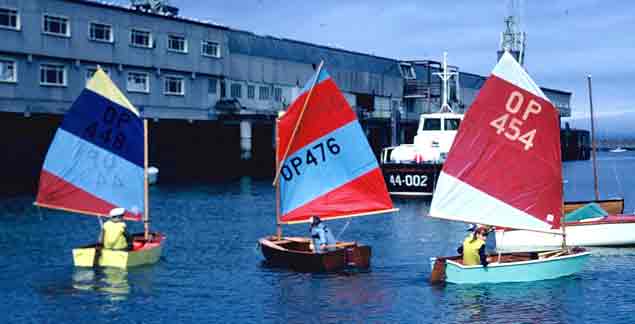 The first of the new fleet sails. Paddy Boyd (left) Ann Kirwan (centre) and Vivienne Lavery right) getting to know their boats
The first of the new fleet sails. Paddy Boyd (left) Ann Kirwan (centre) and Vivienne Lavery right) getting to know their boats
While Johnny Hooper had introduced the idea, he stood back from its continuing implementation, for the Hooper modus operandi was to give an idea enough strength to soon have wings of its own. That certainly happened in the National Yacht Club, for very quickly a manageably small committee was in being, and the formidable Carmel Winkelmann became its secretary. The NYC Junior Programme became her baby, and it always has since been seen as such, even though the number of people involved in administering the programme over the fifty years, as the NYC facilities have expanded and developed to meet the needs of a modern membership, will now run into the hundreds.
In fact, properly organized junior sailing with boats specifically designed for young people’s needs is now so central to Irish sailing that it takes a huge leap of the imagination to visualize the scene as the first small group of National Yacht Club Optimist Dinghies – most of them locally-built either by amateurs or professonals – began to emerge in May 1967 with numbers increasing as each weekend passed. New they may have been, but they reflected their era, with a public Blessing of the Boats outside the Brindley household as a new batch of boats appeared.
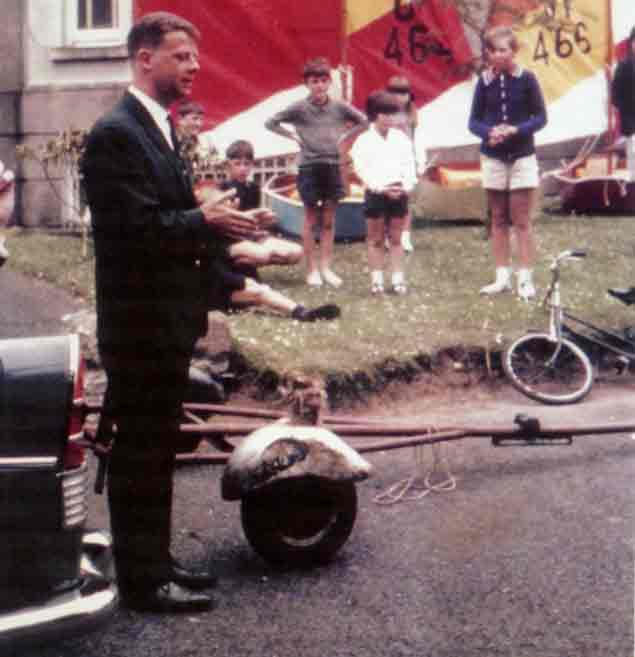 Olympic sailor Johnny Hooper speaking at the Blessing of the Boats as a new batch of home-built Optimists awaits transfer to the National’s limited space.
Olympic sailor Johnny Hooper speaking at the Blessing of the Boats as a new batch of home-built Optimists awaits transfer to the National’s limited space.
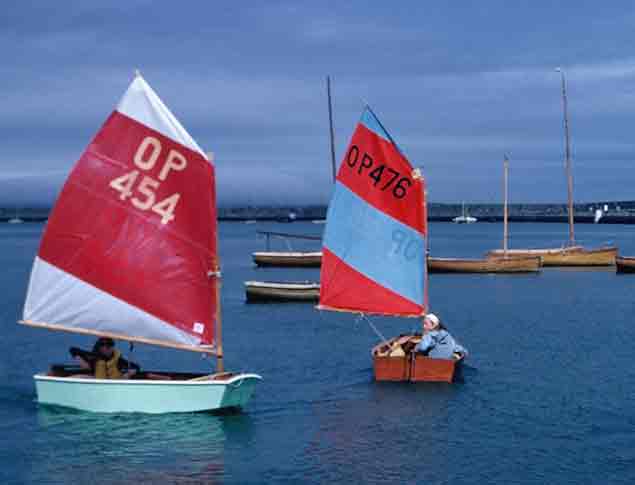 Dun Laoghaire was a different place in those days, with Water Wags and Mermaids expected to lie to mooring. Vivienne Lavery and Ann Kirwan testing their skills with the new Optimists – Ann’s boat (476) was one of the few professionally-built in the first batch of Optimists, she was created by the legendary Skee Gray
Dun Laoghaire was a different place in those days, with Water Wags and Mermaids expected to lie to mooring. Vivienne Lavery and Ann Kirwan testing their skills with the new Optimists – Ann’s boat (476) was one of the few professionally-built in the first batch of Optimists, she was created by the legendary Skee Gray
But though most young sailors in theory had his or her own boat, before anything approaching full fleet numbers was approached they’d a habit of letting anyone sail some boat or other in the early stages, so much so that although Ann Kirwan was part of it from a very early stage, she admits that even she can’t claim total accuracy when identifying the helm of a known boat.
 Going abroad......the new Dun Laoghaire Optimists make their debut at Bray Regatta: Paul, Adam and Lucy Winkelmann with Paddy Kirwan putting in his renowned act as a South American Air Marshall at Bray Sailing Club.
Going abroad......the new Dun Laoghaire Optimists make their debut at Bray Regatta: Paul, Adam and Lucy Winkelmann with Paddy Kirwan putting in his renowned act as a South American Air Marshall at Bray Sailing Club.
This habit of inter-changing sailors became even more marked in that first year when the early class discovered that the most useful base for their day-time sailing was the little-used Irish Lights service barge moored in the western part of the harbour. Over there, NYC Optimist sailors found much clearer sailing water, and they were well away from the comings and goings of the two cross-channel ferries off their home club, not to mention excessive parental control. In effect, the barge became their day-time base, and they ate their packed lunches aboard it while deciding who would take which boat for the first stage of the afternoon’s sailing. Fifty years down the line, we might well wonder if the Commissioners of Irish Lights are aware of the key role their humble barge played in launching Ireland’s Junior Training Programme.....
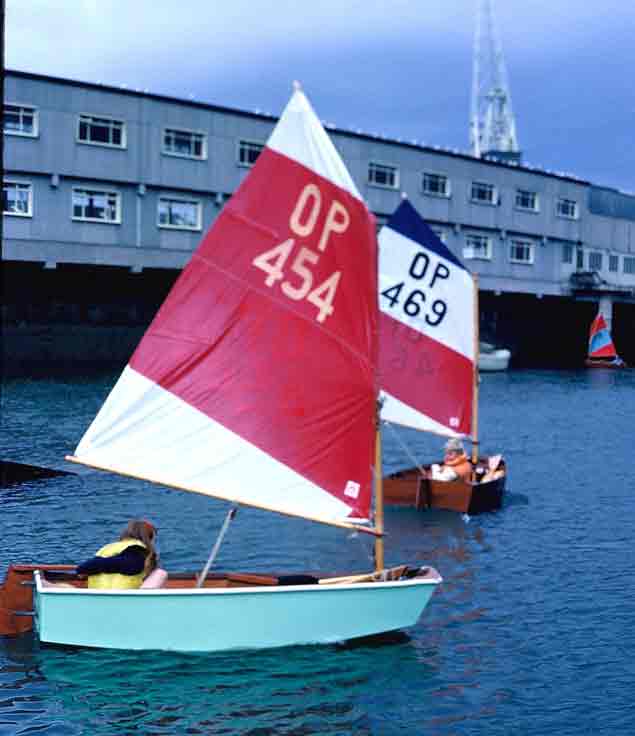 Vivienne Lavery and David Ryan getting away from the slip.
Vivienne Lavery and David Ryan getting away from the slip.
Once launched in its viable form in 1967, there was no stopping it, and the names which have emerged just from the National’s junior programme alone (for virtually all clubs now have one) take us over an extraordinary range, and up to the heights of Olympic participation, the winning of major world dinghy championships and associations with the America’s Cup.
It’s Johnny Smullen who provides the latter. The California-based Johnny Smullen in San Diego is now of world stature in anything to do with yacht and boat-building or indeed in marine construction generally, and his talent has been recognized at the highest level as he has worked on major projects for the very demanding Dennis Conner, aka Mr America’s Cup.
Johnny will have inherited his feeling for classics from his father Cass, a great sailor who was such an enthusiast for the Dublin Bay 21s in their original rather spectacular gaff-rigged form that when the class contemplated changing to a more easily-handled and convenient Bermudan rig in 1963, Cass claimed that he could easily rig a gaff-rigged DB 21 in 15 minutes flat. And that included setting the jackyard topsail to perfection. So he brought a DB 21 close into the clubhouse (as you could in those days), and in front of a drink-sipping crowd of observers on the verandah, he did the job within 15 minutes. But they still went ahead and converted to Bermudan rig.
Son Johnny meanwhile was enlisted in the NYC Junior Programme as soon as he reached he lower age limit, and when the 40th Anniversary was being celebrated back in 2007, he sent on his memoirs which well capture the flavour of it all:
San Diego, 17th May 2007
The way I saw it.
I am eight years old and my parents are wondering what to do with me for the summer, it went something like this: “Get him out from under our feet”. I was equally happy to stay at home and play in the back garden, invent stuff and dream up ways to frighten my sisters. Chasing them with worms was a good one.
I was enrolled in the adventure of my life.
At first I was lead to believe it was going to be a fun thing with the opportunity to meet new people and friends, maybe making me more sociable as I was quiet child in a world of my own. I bought into this and showed up for the first day. It was great, lots of people all different shapes and sizes, so there we were all sitting around playing with stuff and one-upping on how my father is better than yours, especially at snooker. The chatter fell silent when along came this very tall white-haired lady with an incredibly loud voice. It was at this point I became suspicious as I had just watched Paths of Glory and A Bridge Too Far, I had seen how the enemy rounded up people and put them in trucks and brought to places, unfriendly places.....
We arrived at Sandycove harbour where we were lined up on the pier. I though this was it, we were then forced to line up at the steps and walk down into the freezing water fully clothed and flail around, there were guards (instructors we were led to believe) everywhere, and just to make sure the torture was effective they made us hold our heads under water for 30 minutes, well 30 seconds, but it felt like minutes. Then we were all forced to walk back to the NYC where our fate was to be determined. Freezing and scared, I was cursing my family and wondering what I had done to them.
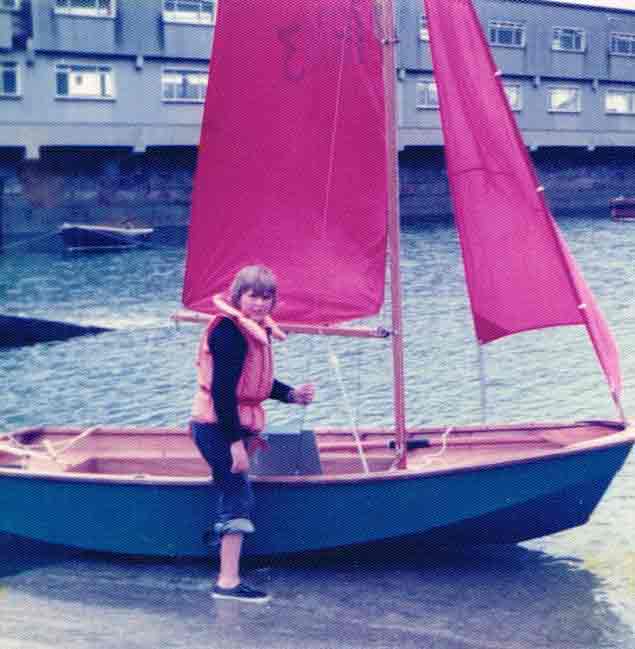 He survived.....eventually Johnny Smullen became a keen Mirror dinghy sailor, but he was pessimistic enough to call his boat Splinter
He survived.....eventually Johnny Smullen became a keen Mirror dinghy sailor, but he was pessimistic enough to call his boat Splinter
We arrived back at Camp NYC and were lined up and made to wear large cumbersome protective coats, some were yellow, purple, some orange, I guessed they were labelling us, something to do with our religion. Some of these jackets had large protective collars probably to help protect us from the beatings to come, I thought. Our names were branded onto the “Life Jackets” as I started to call them, knowing they would play a key role in our protection.
We were divided into groups and lead away by the guards into this large damp room with arches and a dank smell of cotton, hemp and mould. This was where we were to remain for all the rainy days to be brain-washed, they started by teaching us knots. I was convinced this was going to be how to tie the very knot that would be the doom of us, I compared it to carrying the cross of Calvary. I decided then to be really bad at it in the hopes that one of my knots would slip open and I could dash to my freedom. We also had to jump up, and hand-over-hand along the light blue steel beam that ran across the dark room, this was to make our arms really strong, they had a plan for strong arms – I will tell you about that a little later.
Food consisted of a march up to Wimpeys for a spice burger and chips all drowned in vinegar to disguise the taste, if there was good behaviour we got to go to the Miami Café. The day was long (except Thursdays when we had to get out early) and after a week in Boot Camp we were all tired and weary. What had I done to my family to deserve this?
The second week came along and we were introduced to the ships, rather large wooden craft resembling a landing craft with the flat bow (I was always looking for the hinges). This is where the strong arms came into. We were grouped into six per team, and the guards waited until low tide when we had to carry the ship down a rickety wooden slip (there’s a reason for calling it a slip). Upon its surface there were large wooden rollers but we were forbidden to use those rollers, and to make sure they filed a fat spot on the rollers, deeming them useless. We picked up the incredible heavy boat, all six of us, one on each corner holding a knee, and two in the middle by the oar locks. Later I was to learn the place to be was up at the bow (by the door), it was lightest. I was adapting to this cruel camp. As we descended down to the icy water again fully clothed, we came across a bright green pungent slime. I had what I thought were special sailing shoes, but as soon as I touched the slime I was down. Down hard. The guards started yelling, I knew I had to get up quickly....remember Calvary!....We reached the bottom and stopped, the guards yelled again and made us wade right into the icy deep, still fully clothed. With the landing craft now floating, we had to master manoeuvring, the craft were lined up alongside the slippy slip, that’s the reason they call it a..................
I stepped on the gunwhale. Now at this point I did not understand the physics like I do today, and when you apply a load to any point of the gunwhale of a flat-bottomed craft two things will happen (once only). The opposing gunwhale will come up as you travel down, and because I am as tall as the craft is wide, somewhere in the middle he two surfaces will meet, your face and the opposing gunwhale. After the initial shock, the second shock comes from the icy cold water. Then I found out what the large collar was for as the guards hauled me out of the abyss semi-conscious. Once inside the craft, we were grouped into two and handed oars. Let the games begin.....
After a week of rowing and shipping oars and coming alongside we were all adapting well to boating, there’s nothing to it. Just as we are enjoying ourselves, we are reminded that this is a work camp with launch and retrieval exercise twice a day. The launch and retrieval is carefully timed at 6 and 12 hours intervals to make sure it was low tide and we’d the longest slimiest walk up the rickety slips, observed closely by the guards from the window of the snooker room glaring down at us. Boating is turning out to be challenging but fun, and the new friends are all pitching together to eventually plan an assault on the guards to free ourselves.
The third week came along and there were large wooden poles with white canvas and a stick with notches cut out of it, why on earth did they have to make it harder? It was perfectly simple with the clean decks and oars and oar locks, now the boats are so heavy with this rig up, my bow lifting position is not that smart as we carry down the slip with the sail pressed hard against my face. After countless days of theory brainwashing in the damp room, we have to pass a few tests to prove worthy to sail, if called upon, out to the US Aircraft Carrier John F Kennedy anchored out in Dublin Bay. The first test was to take the stick with the notches and stretch out the canvas and hook onto a rope loop, without falling over this was harder than carrying the feckin’ boat, the second was to line up two pins while hanging over the transom full of chips and spice burgers. If it had hair....
Most of us mastered that task after a few tries, and it wasn’t long before we were sailing out to the sterns of the ferry Hibernia or Cambria, whichever was in port at the time. This went on for a few weeks and as we settled into the routine it got easier as we went on.
During the time in the damp boathouse, usually when it was blowing dogs off chains outside and while I was trying to get the batteries out of the loudhailer, I noticed a beautiful varnished clinker planked boat, it was almost new, and a very wise man was looking after it. This Man was tough as the rivets holding it together and knew everything about the seas. I knew if I paid attention he would help get me through the summer, he did and he is almost responsible for what I do today. Thank you Jack!
The discipline of Boot Camp had turned us into great sailors, great card players, snooker players....it wasn’t until the third stage we found flagons. But not on the night of May 17th 1975, I was at home doing my homework that night....
Ah.....the memories, I hope I have stirred a few, it was the most wonderful time of my life and I wish I was there to get drunk with all of you and play cards till the wee hours, but meanwhile thanks
To Carmel, thank you very much; I always have my lifejacket.
To Jack Brennan, I am always thinking of you up there, and thanks for teaching me how to tie my shoelaces.
To all the instructors Paul, Ann, Jimmy, I never believed the story of the rabbit and the tree, but thanks anyway
And to all my dear family and friends
Lots of love, Johnny Smullen
PS It was me that stuck the coke bottle in the cannon at the front of the club....
 Johnny Smullen and Dennis Conner inspect the hull of the 1925-built Cotton Blossom
Johnny Smullen and Dennis Conner inspect the hull of the 1925-built Cotton Blossom
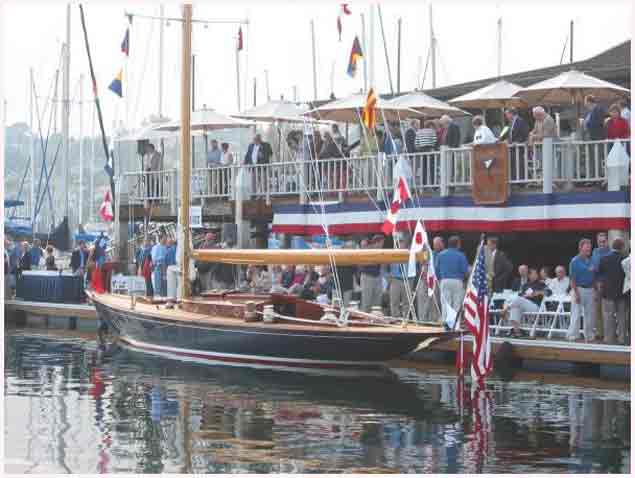 Cotton Blossom II after restoration by Johnny Smullen
Cotton Blossom II after restoration by Johnny Smullen
Inspired by Jack Brennan and other master craftsmen, Johnny has gone on to become a shipwright of such skill from his base in San Diego, California, that he in turn inspires others, one of his most famous projects being the complete restoration of the 49ft Q Class sloop Cotton Blossom II of 1925 vintage.
When a complete restoration is contemplated, Johnny doesn’t mess about. The word is that when he and Dennis turned up to finalise the deal on Cotton Blossom and bring her back to San Diego, they found the previous owners sorry enough to see her go, and rather proud of the style in which they’d maintained her. But after they’d gone to sort the details with the new owner, they went to take a last look at the boat. It’s said they found that Johnny had already delivered his opinion on the existing rig by cutting the shrouds and stays at the deck with bolt-croppers, and cutting the old mast off at deck level with a chainsaw.
Maybe that’s an apocryphal Johnny Smullen from taking delivery of another boat. Yet when you see Cotton Blossom in her restored form, it’s clear what Johnny says should indeed be Holy Writ. This is a project of world standard. But what’s even more remarkable is that despite everything the Sailing Boot Camp at the NYC might have inflicted on him all those year ago, Johnny’s love of boats and sailing is such that he has his own personal sweet classic, the lovely 36ft International One Design Altair. She’s sailed as often as possible, and though he can’t make it back to Dun Laoghaire next month for the Golden Jubilee as there’s very major project under way, Altair will be racing with the San Diego classics under the National Yacht Club burgee.
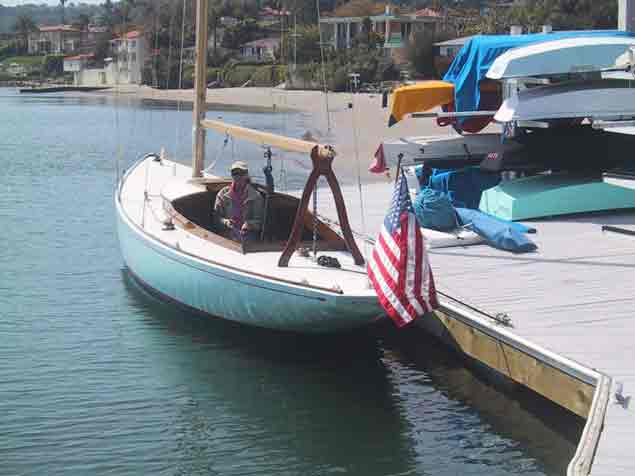 Johnny Smullen’s own pet boat Altair reveals his abiding love of sailing.
Johnny Smullen’s own pet boat Altair reveals his abiding love of sailing.
John Lavery’s father Arthur was another of those pioneering Optimist dads back in the late 1960s, and John and his sister Vivienne were both in that first batch of trainee sailors. He ended up winning championships in more classes then you could quickly count, but the peak of it all came in September 1995 when he and David O’Brien of this parish won the Fireball Worlds in Dublin Bay.
In fact, the graduates from 50 years of a junior training programme at the National YC can be found in successful positions in many boat classes in many places, but it is the club’s outgoing attitude to those who wish to learn to sail which deservedly provided its most outstanding success. A long time ago a Mrs MacAleavey, a widow with no sailing connections, was looking for a club which would make her increasingly boat-mad daughter Cathy – who had recently bought a clapped-out 420 – feel encouraged in any way to learn to sail. Despite the fact that it was still in process of recovering from a fire in the clubhouse, the NYC showed itself the most welcoming along the Dun Laoghaire waterfront, so much so that Mrs McAleavey felt sufficiently encouraged to buy her daughter a new 420, and that in turn led on eventually to Cathy representing Ireland in the women’s 470 in the 1988 Olympics.
The three children she had with husband Con Murphy went on to get their introduction to sailing through the National YC’s junior programme, and daughter Annalise emerged with the talent and the burning ambition which resulted in a heart-breaking fourth at the 2012 Olympics in the Women’s Laser Radial when a medal had seemid almost certainly within her grasp. But memories of that were entirely laid to rest with the Silver Medal in the 2016 Olympics Rio after a difficult final race in which the lone sailor seemed to stay as cool as you please, while the nation at home watched with bated breath.
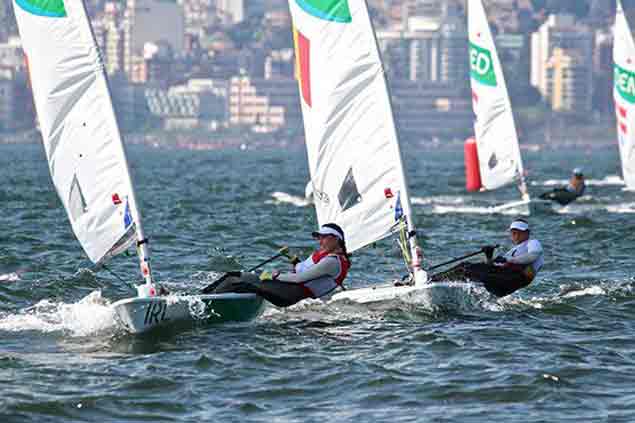 The medal-winning moment as Annalise Murphy crosses the finish line in Rio to win Silver.
The medal-winning moment as Annalise Murphy crosses the finish line in Rio to win Silver.
That it was ultimately a very personal achievement is something respected by her club, and they claim to have done nothing more than provide the first steps on the pathway, and a general spirit of encouragement. But nevertheless the success is all of a piece with the Golden Jubilee which will be celebrated on May 20th, and Carmel Winkelmann continues in her mission of providing a background of training for young sailors of all types, whether they aim only to be a competitive club sailor, or whether they aim for the ultimate heights.
Thus one of her projects in recent years was to find real support for young Finn Lynch, who had reached that difficult stage of being a top junior sailor, yet still had to find his feet as an adult. Thanks to support raised by Carmel, he became Ireland’s representative in the Men’s Lasers at Rio despite going through the final stages of the selection with a training injury recovery problem which may have had an adverse effect on his performance in as the youngest sailor in Rio, aged just 20.
Whether or not he would have been better off not being in Rio at all is neither here nor there. When you’re 20, four years can seem an appallingly long time. The Tokyo Olympics in 2020 must have seeemed aeons away for a young sailor who had shown many flashes of real talent. It was better for him to be in Rio while learning a lot, rather than kicking his heels in frustration in some dead end. And when he needed material help to see through the campaign, it was Carmel Winkelmann who was there to make to ensure that support was available. That will be something else for celebration on May 20th.
 Carmel Winkelmann and Finn Lynch at the National Yacht Club, June 2016. Photo W M Nixon
Carmel Winkelmann and Finn Lynch at the National Yacht Club, June 2016. Photo W M Nixon


























